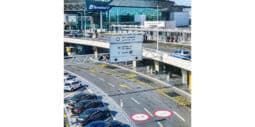

24786 views
Piazza Venezia or Venice Square is located in the center of four major roads of Rome. These roads are the Via del Corso, Via del Plebiscito, Via di Teatre Marcello, and Via dei Fori Imperiali. Also, the square is famous for its chaotic traffic. Piazza Venezia was named after the Cardinal Venezia, who ordered the construction of his place, Palazzo Venezia, in 1455. This building later became the seat of “Serenissima” (Republic of Venice).
Contents
ToggleThe most famous monument located on Piazza Venezia is dedicated to King Victor Emmanuel II, the first king of Italy, and is called Il Vittoriano. It is also referred to as the Altar of the Fatherland (Altare della Patria) and was made from white marble in 1911.
There is a military museum and terrace with the views of Rome
Moreover, the monument is known as “The Wedding Cake” or “The Giant Typewriter” and features statues, frescoes, columns, and majestic staircases. The monument was highly criticized for clashing with the existing architecture surrounding it. Additionally, in order to create such a massive building, many ruins, medieval churches, and properties on the northern part of Capitoline Hill were cleared.
Palazzo Venezia is the building that gave the square its name and was built between 1455 and 1464 by Cardinal Pietro Barbo, who went on to become Pope Paul II.
Palazzo Venezia is one of the oldest Renaissance buildings in the Eternal City
It was a papal residence until Pope Pius IV handed it to Venice, and the building was used as the embassy. However, in 1916, the Italian government acquired the palace, where Benito Mussolini made it his headquarters during the Fascist era. Dictator Mussolini gave his speeches from Palazzo Venezia. Today, the building is home to the Museo del Palazzo Venezia, where you can find a collection of historic artworks such as Renaissance paintings, ceramics, sculptures, and other decorative arts.
The Palazzo delle Assicurazioni Generali is located across the Palazzo Venezia, built between 1906 and 1911. The palace replaced two other buildings in 1900 to make the square more expansive. Its founder is Marco Besso, an Italian entrepreneur in the sphere of real estate and was the President of the insurance company located in this building.
It was Michelangelo Buonarroti’s house where he lived and died, commemorated by a plaque on the side facing the Altar of the Fatherland
Located on the right part of the Palazzo Venezia, Palazzo Bonaparte is dedicated to Maria Letizia Ramolino (Buonaparte), mother of Emperor Napoleon. Moreover, after the fall of Bonaparte’s empire, Pope Pius UII presented his mother asylum. She lived there in the 17th century until she died in 1836.
The Basilica of San Marco is one of the oldest basilicas in Rome, built in 336 A.D. It was reconstructed several times and, in 1451, became part of the Palazzo Venezia. The basilica is located in Piazza San Marco Square, but Piazza Venezia surrounds this square. The sculpture of Madame Lucrezia at the basilica was placed by Cardinal Lorenzo Cybo in 1500 when he was the Cardinal of San Marco. Madame Lucrezia represents the Egyptian goddess Isis.
Hotel Castellino Roma is an elegant hotel just 100 meters from Piazza Venezia. It offers a sun terrace with views of the city. Moreover, all rooms are with amenities, free bathrobes, and slippers. It would be an excellent option for travelers who want to explore the city because all the main sites are located within walking distance.
Piazza Venezia is also famous because of Alberto Sordi’s performance in the comedy by Luigi Zampa “The Traffic Policeman” (1960)
Undoubtedly, there are no Roman Holidays without a visit to Piazza Venezia. It is one of Rome’s most beautiful and meaningful squares, which connects the main streets, monuments, and ruins, being the central point of the city.
Author: Kate Zusmann
This website uses cookies. For more info read the cookies policy
Rome.us © 2025. Created with love by Roman experts and guides.